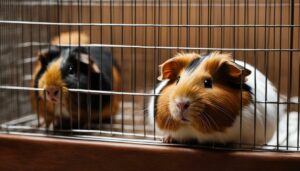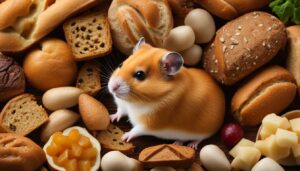Gerbils, specifically Mongolian gerbils or Mongolian jirds, inhabit the highlands of Inner Mongolia, southern Siberia, and northern China. These small creatures are well-adapted to survive in the dry landscapes they call home, including deserts, grasslands, scrub, arid steppes, and mountain valleys. The extreme climate in these regions poses challenges, with temperatures ranging from -40 degrees Celsius in winter to 50 degrees Celsius in summer. Despite these harsh conditions, gerbils have developed unique behaviors and characteristics to thrive in their natural habitats.
Key Takeaways:
- Gerbils are found in the highlands of Inner Mongolia, southern Siberia, and northern China.
- They live in dry landscapes such as deserts, grasslands, scrub, arid steppes, and mountain valleys.
- Gerbils face extreme climates, with temperatures ranging from -40 degrees Celsius in winter to 50 degrees Celsius in summer.
- They live in family groups and build burrows near plants for support.
- Gerbils primarily feed on mugwort, saltwort, bristle grass, and lyme grass.
The Dry Landscapes of Gerbil Habitats
Gerbils thrive in dry landscapes, including deserts, grasslands, scrub, arid steppes, and mountain valleys. These habitats pose unique challenges for gerbils due to the extreme climate and limited resources available. In regions such as Inner Mongolia, southern Siberia, and northern China, where Mongolian gerbils or Mongolian jirds are commonly found, temperatures can plummet to -40 degrees Celsius in winter and soar to 50 degrees Celsius in summer.
These wild gerbil habitats experience low annual precipitation and long winters, making it essential for gerbils to adapt to survive. They have developed remarkable behaviors and physiological adaptations to cope with the challenging environment. Gerbils live in family groups and construct intricate burrows near plants for support, protection, and insulation against the elements.
To meet their nutritional needs, gerbils primarily feed on plants like mugwort, saltwort, bristle grass, and lyme grass. These plants have adapted to thrive in arid conditions, providing the necessary sustenance for gerbils. Additionally, gerbils have evolved to conserve water and fat effectively, allowing them to survive extended periods of drought and scarcity.
Despite the harsh climate, gerbils have developed various strategies to maximize their chances of survival. They are active foragers, constantly searching for food, and engage in sandbathing to maintain their hygiene and regulate body temperature. Gerbils are also known to be inactive during the hottest and coldest parts of the day, minimizing their exposure to extreme temperatures. These behavioral adaptations play a crucial role in their ability to thrive in the wild.
The Dry Landscapes of Gerbil Habitats Table
| Gerbil Habitat | Characteristics |
|---|---|
| Deserts | Extremely dry; sparse vegetation; fluctuating temperatures |
| Grasslands | Wide open spaces with grasses and occasional shrubs; moderate temperatures |
| Scrub | Low-growing vegetation; hot and dry conditions |
| Arid Steppes | Treeless plains with short grasses; wide temperature variations |
| Mountain Valleys | High altitudes; rocky terrain; cooler temperatures |
In conclusion, gerbils have adapted remarkably to the dry landscapes they inhabit. Their ability to survive and thrive in hostile environments is a testament to their resilience and evolutionary ingenuity. As fascinating creatures, they offer valuable insights into ecological settings and serve as popular pets due to their intelligence and low-maintenance requirements. Understanding gerbils’ natural environment and their ability to cope with extreme conditions contributes to our broader knowledge of wildlife and the remarkable adaptations found in nature.
Extreme Climate and Adaptability of Gerbils
Gerbils endure extreme climates, with temperatures ranging from -40 degrees Celsius in winter to 50 degrees Celsius in summer. These small rodents have developed remarkable adaptability to survive in such challenging conditions.
In their native habitats, which include the highlands of Inner Mongolia, southern Siberia, and northern China, gerbils have evolved to cope with the harsh climate. The regions where they live experience low annual precipitation and long winters, characterized by freezing temperatures and scarce food availability. In contrast, summers bring scorching heat and the need for water conservation.
To thrive in these environments, gerbils have developed various behavioral adaptations. They exhibit specific foraging behaviors, relying on a diet primarily composed of mugwort, saltwort, bristle grass, and lyme grass, which are well-suited to their arid surroundings. They have also evolved an efficient metabolism that allows them to conserve both water and fat, enabling them to endure extended periods without sustenance.
Gerbils have further adapted to extreme climates by exhibiting thermoregulation behaviors. They are inactive during the hottest and coldest parts of the day, minimizing their exposure to temperature extremes. Additionally, gerbils engage in sandbathing, a behavior that helps them regulate their body temperature and keep their fur clean.
| Gerbil Adaptations to Extreme Climates |
|---|
| Efficient foraging behaviors |
| Water and fat conservation abilities |
| Thermoregulation through inactivity |
| Sandbathing for body temperature regulation and fur cleanliness |
These adaptations demonstrate the remarkable resilience and resourcefulness of gerbils, allowing them to not only survive but thrive in their native habitats. Their ability to endure extreme climates has also made them valuable subjects in scientific research, contributing to a better understanding of physiological and behavioral responses to harsh environmental conditions.
Beyond their significance in research, gerbils’ adaptability and ease of care have made them popular pets worldwide. Their intelligence, social nature, and low maintenance requirements make them ideal companions for many individuals and families.
In summary, gerbils’ native habitats present extreme climates that range from freezing winters to scorching summers. Despite these challenges, gerbils have adapted to survive and thrive in such conditions through specialized foraging behaviors, water and fat conservation abilities, thermoregulation practices, and sandbathing. These remarkable adaptations have not only allowed gerbils to flourish in their wilderness dwellings but also contribute to their popularity as pets and their significance in scientific research.
References:
- Ghosal, R., & Sarkar, P. (2015). Integrated strategies for dryland agriculture development. New Delhi: Springer.
- Nowak, R. M. (1999). Walker’s mammals of the world. Baltimore: Johns Hopkins University Press.
Burrows and Family Groups of Gerbils
Gerbils live in family groups and construct burrows near plants for support and protection. These burrows serve as their homes and provide shelter from predators and extreme weather conditions. The burrows are typically complex structures with multiple entrances and various chambers for different purposes.
Within the family group, there is a social hierarchy, with dominant members asserting their authority and taking charge of protecting the group. They are responsible for marking the burrows and surrounding areas with scent glands to establish territorial boundaries and communicate with other gerbils.
The burrows are strategically built near plants for both structural support and a reliable food source. Gerbils feed on the roots, seeds, and leaves of various plants, including mugwort, saltwort, bristle grass, and lyme grass. Their burrows are often interconnected with underground tunnels that lead to feeding areas, allowing them to access food without exposing themselves to potential danger.
Overall, the construction of burrows and living in family groups is a crucial adaptation for gerbils to survive in their natural habitat. It provides them with protection, access to food, and a social structure that ensures the well-being of the group.
| Burrow Structure | Family Groups | Food Sources |
|---|---|---|
| Complex structures with multiple entrances and chambers | Hierarchical social structure with dominant members | Roots, seeds, leaves of plants such as mugwort, saltwort, bristle grass, and lyme grass |
| Strategically built near plants for support and food | Territorial marking with scent glands | Underground tunnels connect burrows to feeding areas |
Feeding Habits of Gerbils in the Wild
Gerbils primarily feed on mugwort, saltwort, bristle grass, and lyme grass in their natural habitat. These plants provide the essential nutrients and hydration necessary for their survival in the challenging wilderness. Mugwort, known for its antibacterial properties, is a common food source for gerbils due to its availability and medicinal benefits. Saltwort, with its high salt content, helps gerbils maintain electrolyte balance in their bodies, especially in arid environments where water sources are scarce. Bristle grass and lyme grass, rich in fiber and carbohydrates, provide the energy required for gerbils to thrive in their harsh surroundings.
Although gerbils primarily rely on these plants, their diet may vary depending on the availability of food sources in their specific habitats. They have the remarkable ability to adapt their feeding habits according to the resources present in their environment. This adaptability allows gerbils to survive in regions with low annual precipitation and limited vegetation, ensuring their continued existence in these inhospitable landscapes.
Notable Feeding Behaviors
When foraging for food, gerbils exhibit certain behaviors that enable them to efficiently exploit scarce resources. They are known to make shallow burrows beneath plants, allowing them to obtain support while feeding. This behavior also helps protect gerbils from predators and extreme weather conditions. Gerbils are opportunistic feeders, taking advantage of the seasonal abundance of food sources. They consume and store excess food, particularly during periods of plentiful resources, to sustain themselves during lean periods. This ability to store food allows gerbils to survive in regions where food availability fluctuates throughout the year.
| Preferred Gerbil Food | Benefits |
|---|---|
| Mugwort | Antibacterial properties, availability |
| Saltwort | Electrolyte balance, salt content |
| Bristle grass | Fiber, carbohydrates |
| Lyme grass | Energy, carbohydrates |
In conclusion, gerbils have evolved to adapt their feeding habits to survive in their natural environment. They primarily rely on mugwort, saltwort, bristle grass, and lyme grass as their main sources of nutrition and hydration. Their ability to forage, store food, and adjust their diet according to available resources allows them to thrive in the extreme climates and landscapes they call home. By understanding their feeding habits, we gain valuable insights into the remarkable adaptability of these fascinating creatures.
Water and Fat Conservation in Gerbils
In their harsh habitat, gerbils have evolved the ability to efficiently conserve water and fat. The extreme climate and low annual precipitation make water a scarce resource for these small creatures. To overcome this challenge, gerbils have developed several remarkable adaptations.
Firstly, gerbils possess specialized kidneys that enable them to produce concentrated urine, reducing water loss. Additionally, they have the ability to extract moisture from their food, including dry vegetation such as mugwort, saltwort, bristle grass, and lyme grass. These plants not only provide sustenance but also contain water content that helps gerbils stay hydrated.
Water Conservation Mechanisms
Gerbils have also adapted their behavior to conserve water. They are most active during the cooler hours of the day and limit their activity during the hottest periods, reducing the need for water intake. Furthermore, gerbils exhibit sandbathing behavior, rolling in sand to exfoliate their fur and absorb moisture through their skin, allowing them to conserve water.
In terms of fat conservation, gerbils store excess fat in their bodies, providing a reserve for times when food scarcity is more pronounced. This fat acts as an energy source during periods of limited food availability, helping gerbils survive through harsh winters and droughts.
Overall, the ability of gerbils to efficiently conserve water and fat in their natural environment is essential for their survival. These adaptations enable them to thrive in the wild, inhabiting regions with extreme climates and scarce resources. Understanding these mechanisms not only sheds light on the remarkable resilience of gerbils but also contributes to our knowledge of how animals adapt to challenging environments.
| Water Conservation Mechanisms | Fat Conservation Mechanisms |
|---|---|
| – Producing concentrated urine | – Storing excess fat as an energy reserve |
| – Extracting moisture from food | – Utilizing fat during food scarcity |
| – Restricting activity during hottest periods of the day | |
| – Sandbathing to absorb moisture through the skin |
Behavioral Adaptations for Survival
Gerbils exhibit various behavioral adaptations, such as foraging, sandbathing, and adjusting activity levels during extreme temperatures. These adaptations allow them to thrive in their challenging natural environment and ensure their survival.
Foraging is a crucial behavior for gerbils in the wild. They have developed efficient techniques to search for and gather food. Gerbils primarily feed on plants such as mugwort, saltwort, bristle grass, and lyme grass, which are abundant in their natural habitat. By actively searching for these food sources, gerbils ensure a steady supply of nourishment, even in the harsh conditions they face.
Another behavioral adaptation of gerbils is sandbathing. They instinctively roll in fine sand or dust, which helps to keep their fur clean and free from parasites. Sandbathing also plays a role in thermoregulation, as the sand particles help to absorb excess moisture from the gerbils’ bodies, keeping them dry and preventing heat loss.
Gerbils also adjust their activity levels in response to extreme temperatures. During the hottest parts of the day, they reduce their activity and seek shade or retreat to their burrows to cool down. Similarly, during the coldest periods, gerbils become less active and conserve energy to survive in the low temperatures. These behavioral adjustments allow gerbils to maintain their body temperature and conserve energy, enabling them to survive in their demanding natural environment.
| Behavioral Adaptations | Significance |
|---|---|
| Foraging | Ensures a steady food supply |
| Sandbathing | Cleans fur and aids in thermoregulation |
| Activity Level Adjustment | Thermoregulation and energy conservation |
In summary, gerbils possess a range of behavioral adaptations that allow them to survive and thrive in their natural environment. Their ability to forage efficiently, engage in sandbathing to clean their fur and regulate body temperature, and adjust their activity levels in response to extreme temperatures are all critical factors in their success as a species in challenging habitats. These behavioral adaptations also contribute to the appeal of gerbils as pets and their significance in scientific research.
Communication Methods of Gerbils
Gerbils rely on tactile and chemical cues for communication within their social groups. These small rodents have developed an intricate system of communication to navigate their wild habitats and interact with other members of their species. By understanding how gerbils communicate, we can gain insight into their social dynamics and survival strategies.
In terms of tactile communication, gerbils use physical contact to convey information. They may engage in grooming behaviors, such as licking or nibbling each other, to establish social bonds and strengthen relationships within their family groups. This tactile interaction also serves as a form of reassurance and support in a challenging environment.
Chemical cues, such as scent marking, play a crucial role in gerbil communication. Each gerbil has scent glands located on various parts of its body, including the cheeks, chin, and stomach. By rubbing these glands against objects or other gerbils, they leave behind scent marks that convey messages about territory, reproductive status, and social hierarchy. Through these chemical signals, gerbils can establish boundaries and recognize familiar individuals.
Table 1: Gerbil Communication Methods
| Communication Method | Description |
|---|---|
| Tactile cues | Gerbils use physical contact, such as grooming behaviors, to communicate and establish social bonds. |
| Chemical cues | By scent marking, gerbils leave behind chemical signals that convey information about territory, reproductive status, and social hierarchy. |
Understanding the communication methods of gerbils is essential for their well-being, both in the wild and as pets. Providing opportunities for physical contact, such as through suitable socialization with other gerbils, helps replicate their natural behaviors and foster social bonds. Additionally, allowing gerbils to engage in scent marking activities, such as providing materials for burrow construction, helps satisfy their instinctual need for communication through chemical cues.
In conclusion, gerbils rely on tactile and chemical cues for communication in their social groups. These methods allow them to navigate their wild habitats, establish social bonds, and convey essential information. By understanding and respecting these communication strategies, we can provide gerbils with an environment that promotes their natural behaviors and overall well-being.
Gerbils’ Significance in Research and as Pets
Gerbils have been widely used in research and are popular pets due to their intelligence and low-maintenance requirements. These small rodents have proven to be valuable subjects in various scientific studies, particularly in the fields of physiology, genetics, and behavior. Their compact size, short lifespans, and reproductive efficiency make them ideal for controlled laboratory experiments.
Researchers have utilized gerbils to study various diseases and conditions that affect humans, including cardiovascular disorders, diabetes, epilepsy, and neurodegenerative diseases. Their genetic similarity to humans, especially in terms of brain structure and function, makes them valuable for understanding the underlying mechanisms of these conditions and developing potential treatment strategies.
In addition to their contributions in research, gerbils have gained popularity as pets among individuals and families. Their playful and social nature, along with their ease of care, make them well-suited for households of all sizes. Gerbils are intelligent and can be easily trained, making them enjoyable companions for both children and adults.
As pets, gerbils require appropriate housing, proper nutrition, and regular veterinary care to ensure their well-being. Providing them with a spacious cage, suitable bedding material, and a variety of toys and accessories for enrichment is essential. Additionally, a balanced diet of commercially available gerbil pellets, fresh vegetables, and occasional treats will help maintain their health.
| Gerbils’ Significance in Research | Gerbils as Pets |
|---|---|
| Valuable subjects in physiology, genetics, and behavior studies | Playful and social pets |
| Used to study diseases and conditions affecting humans | Intelligent and easily trainable |
| Genetic similarity to humans aids in understanding disease mechanisms | Low-maintenance requirements |
Gerbils’ Native Habitat Summary
Gerbils thrive in dry landscapes, such as deserts, grasslands, scrub, arid steppes, and mountain valleys. They are specifically found in the highlands of Inner Mongolia, southern Siberia, and northern China. These regions are characterized by extreme climates, with temperatures ranging from -40 degrees Celsius in winter to 50 degrees Celsius in summer. The habitats have low annual precipitation and long winters, making it a challenging environment for survival.
In their natural habitat, gerbils live in family groups and build burrows near plants for support. They have adapted well to conserve water and fat in this harsh environment. When it comes to food, gerbils primarily feed on mugwort, saltwort, bristle grass, and lyme grass. Their feeding habits and ability to adapt to limited resources contribute to their survival in the wild.
Despite the challenging conditions, gerbils have developed specific behavioral adaptations for survival. They forage for food, sandbathe to keep their fur clean, and are inactive during the hottest and coldest parts of the day. These behaviors help them conserve energy and protect against extreme temperatures.
Gerbils communicate with each other using tactile and chemical cues. Their ability to communicate effectively enhances their social interactions and helps them navigate their environment. Additionally, gerbils have been widely used in research due to their unique traits and their popularity as pets is attributed to their intelligence and ease of care.
| Gerbils’ Native Habitat Summary | |
|---|---|
| Gerbil Location | Highlands of Inner Mongolia, southern Siberia, and northern China |
| Preferred Landscapes | Deserts, grasslands, scrub, arid steppes, and mountain valleys |
| Climate | Extreme with temperatures ranging from -40°C to 50°C |
| Family Structure | Live in family groups and build burrows near plants |
| Food Sources | Mugwort, saltwort, bristle grass, and lyme grass |
| Behavioral Adaptations | Foraging, sandbathing, and being inactive during extreme temperatures |
| Communication | Using tactile and chemical cues |
| Research Significance | Widely used in research due to unique traits |
| Popular Pets | Intelligence and ease of care make them popular pets |
Conclusion
Gerbils have adapted to survive in extreme climates and dry landscapes, making their homes in the highlands of Inner Mongolia, southern Siberia, and northern China. These regions are characterized by harsh and challenging conditions, with temperatures ranging from -40 degrees Celsius in winter to 50 degrees Celsius in summer. Despite the low annual precipitation and long winters, gerbils have developed remarkable strategies to thrive in their natural habitats.
In these dry landscapes, gerbils live in family groups and construct intricate burrow systems near plants for support. They have also evolved to feed on specific vegetation such as mugwort, saltwort, bristle grass, and lyme grass, which are able to withstand the arid conditions. Moreover, gerbils possess exceptional water and fat conservation abilities, allowing them to sustain themselves even in the harshest environments.
Through behavioral adaptations, gerbils have further enhanced their chances of survival. They forage for food during the cooler parts of the day, sandbathe to regulate their body temperature, and remain inactive during the hottest and coldest periods. These behavioral strategies enable gerbils to conserve energy and avoid extreme temperature fluctuations, ensuring their overall well-being.
Communication plays a crucial role in gerbil society, and they rely on tactile and chemical cues to interact with one another. These communication methods facilitate social bonds, mating rituals, and the establishment of territories within their natural habitat. Due to their intelligence and ease of care, gerbils have also gained popularity as pets and have been extensively used in scientific research to study various aspects of behavior, physiology, and genetics.
FAQ
Where do gerbils live in the wild?
Gerbils, specifically Mongolian gerbils or Mongolian jirds, inhabit the highlands of Inner Mongolia, southern Siberia, and northern China.
What type of landscapes do gerbils live in?
Gerbils live in dry landscapes such as deserts, grasslands, scrub, arid steppes, and mountain valleys.
What is the climate like in gerbil habitats?
The habitats of gerbils have extreme climates, with temperatures ranging from -40 degrees Celsius in winter to 50 degrees Celsius in summer.
How do gerbils adapt to survive in their habitats?
Gerbils have adapted behaviors such as foraging, sandbathing, and being inactive during the hottest and coldest parts of the day.
What do gerbils eat in the wild?
Gerbils primarily feed on mugwort, saltwort, bristle grass, and lyme grass in their natural habitats.
How do gerbils conserve water and fat?
Gerbils are efficient at conserving water and fat in their challenging environments.
How do gerbils communicate with each other?
Gerbils communicate using tactile and chemical cues.
Why are gerbils significant in research and as pets?
Gerbils have been widely used in research and are popular pets due to their intelligence and ease of care.
What is the summary of gerbils’ native habitat?
Gerbils live in dry landscapes, adapt to extreme climates, build burrows in family groups, feed on specific vegetation, conserve water and fat, have survival behaviors, communicate through tactile and chemical cues, and are important in research and as pets.




